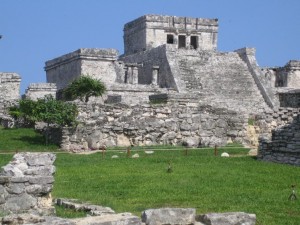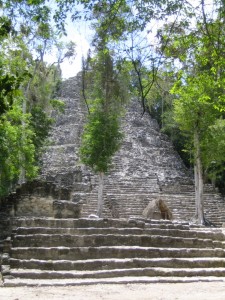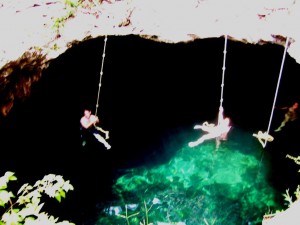
PGA Tour player JJ Henry calculates the yardage for his tee shot at the Mayakoba Classic, the only PGA Tour event played in Mexico.
Just a couple of year ago, before the international financial crisis hit, the Mayan Riviera, as the 100 mile coastal stretch south of Cancun in Mexico’s Yucatan Peninsula is known, has become our hemisphere’s version of Dubai.
Luxury hotels could not open fast enough, including such high end Asian chains as Mandarin Oriental and Banyan Tree, which interestingly chose this are for its first venue into the Americas. Not to be outdone, companies closer to home like deluxe Rosewood jumped in, joined by Fairmont and Viceroy. Then there are a handful of the most exclusive all-inclusive resorts on earth, including one of two outposts of Grand Velas, the first all-inclusive ever to garner AAA’s 5-diamond rating.
Even the PGA Tour got caught up in this fever, bring Mexico’s first and only Tour stop, the Mayakoba Classic, to the region, where it was contested again last week.
In short, the Riviera Maya was sizzling, and it has long been one of my very favorite destinations, offering plenty of golf and a whole lot more. Last time I was there was when I was down for the grand opening of Greg Norman’s high profile El Cameleon course, and at least half a dozen new golf courses were on the drawing board, including a 36-hole TPC complex, Mexico’s first. So after the economy tanked and investment hit the skids, I went back to see how things were going.
I was pleasantly surprised.
Sure, some projects are on hold, and while the billboards for the TPC community are still up, it seems impossible to get any info on the project. Likewise, a new resort from Capella, a new ultra-luxury brand form the guy who ran Ritz Carlton, complete with a high-end Rees Jones course, is taking a very long time to open. But the existing golf courses are thriving, one has expanded from 18-27 holes since the last time I was there, and one notable new one, a Jack Nicklaus Signature course which has gotten very little attention but deserves more, opened in the last year.

The ruins at Tulum, the only city the Mayan civilization ever built on the coast, are just one of the many spectacular sites in this part of Mexico.
What makes the Rivera Maya, I my humble opinion, one of the world’s great tourist destinations?
For starters, it is easy to get to, with lots of flights to Cancun’s modern international airport from all over the US and especially from the entire East coast, easier than anywhere in the Caribbean.
Secondly, it truly has something for everyone, and these are its major charms:
– Incredible Mayan ruins, including towering pyramids. This is the kind of thing you would normally have to go to Peru’s Machu Picchu or Guatemala or Cambodia to see, really impressive stuff with several sites to choose from. The biggies are Tulum, Chichen Itza and Coba, but there are plenty of smaller ones.

Carved from the jungle, the Mayan city of Coba features towering pyramidal structures rivaling any in the Western Hemisphere.
– The word’s second largest barrier reef (after Australia’s Great Barrier Reef), just offshore, offers superlative snorkeling, plenty of cruises, and truly world-class SCUBA diving. In particular, the drift diving off of the island of Cozumel is the stuff of legends.
– An incredible assortment of hotels and resorts of ever style and at every price point: lots of all-inclusives, holes in the wall, lavish resorts, on the beach, in the jungle, in town, truly something for every taste and budget.
– Great attractions and activities: Mayan themed eco-adventure parks like Xcaret are fun rather than hokie, there are ATV trips, horseback riding, zip lines, parasailing, all sorts of activities.
– The towns of Playa del Carmen, the heart and soul of the Riviera Maya, and Tulum (near the ruins) are wonderful beachfront towns that despite the crowds still have real Mexican charm, lots of shopping, eating and nightlife, and are very much worth exploring – or staying in.
– Cenotes. You kind of have to see them to understand, but the entire Yucatan Peninsula is made of thick limestone, and there is water in the form of underground rivers leading to the sea beneath much of it. Cenotes are basically giant round sinkholes in the limestone, some dry, others reaching all the way to underground rivers. These make the ultimate swimming holes, and there are many with rope swings and ladders you can cool off in, often teeming with fish, sort of like swimming in an aquarium. Divers can even travel underground for one cenote to he next. It is definitely worth taking a dip in one, and golfers will encounter dry – but still penal – versions on many area golf courses.
-Food and drink. I happen to love food everywhere in Mexico, and the Mayan Riviera is no exception. Not as fish-centric as the west coast, it still has plenty of good seafood, plus lots of the dishes us Yankees are familiar with, tacos and fajitas and the like. Food is fresh, good and cheap. The going price for four beers – we always order four – is 100 pesos, or about $7.70. Try that from the beverage cart in Scottsdale!
Next post, I will visit the Mayan Riviera’s golf in detail.

